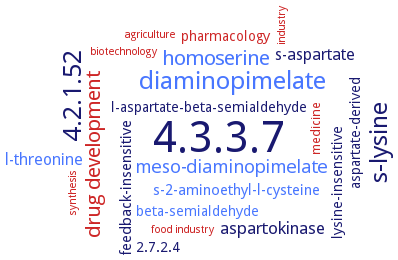4.3.3.7: 4-hydroxy-tetrahydrodipicolinate synthase
This is an abbreviated version!
For detailed information about 4-hydroxy-tetrahydrodipicolinate synthase, go to the full flat file.

Word Map on EC 4.3.3.7 
-
4.3.3.7
-
diaminopimelate
-
4.2.1.52
-
s-lysine
-
drug development
-
homoserine
-
meso-diaminopimelate
-
aspartokinase
-
l-threonine
-
s-aspartate
-
s-2-aminoethyl-l-cysteine
-
feedback-insensitive
-
lysine-insensitive
-
beta-semialdehyde
-
pharmacology
-
l-aspartate-beta-semialdehyde
-
2.7.2.4
-
aspartate-derived
-
medicine
-
synthesis
-
agriculture
-
biotechnology
-
industry
-
food industry
- 4.3.3.7
- diaminopimelate
-
4.2.1.52
-
s-lysine
- drug development
- homoserine
- meso-diaminopimelate
- aspartokinase
- l-threonine
-
s-aspartate
- s-2-aminoethyl-l-cysteine
-
feedback-insensitive
-
lysine-insensitive
- beta-semialdehyde
- pharmacology
-
l-aspartate-beta-semialdehyde
-
2.7.2.4
-
aspartate-derived
- medicine
- synthesis
- agriculture
- biotechnology
- industry
- food industry
Reaction
Synonyms
Aq_1143, AT2G45440, BA3935 gene product, cDHDPS, CjDHDPS, DapA, DapA2, DHDPA synthase, DHDPS, DHDPS2, dihydro-dipicolinic acid synthase, dihydrodipicolinate synthase, dihydrodipicolinic acid synthase, dihydrodipocolinate synthase, dihydropicolinate synthetase, EC 4.2.1.52, FaDHDPS, HTPA synthase, More, MosA, MosA protein, MRSA-DHDPS, PA1010, pyruvate-aspartic semialdehyde condensing enzyme, Rv2753c, synthase, dihydrodipicolinate, VEG81, Vegetative protein 81
ECTree
Advanced search results
Systematic Name
Systematic Name on EC 4.3.3.7 - 4-hydroxy-tetrahydrodipicolinate synthase
Please wait a moment until all data is loaded. This message will disappear when all data is loaded.
L-aspartate-4-semialdehyde hydro-lyase [adding pyruvate and cyclizing; (4S)-4-hydroxy-2,3,4,5-tetrahydro-(2S)-dipicolinate-forming]
The reaction can be divided into three consecutive steps: Schiff base formation with pyruvate, the addition of L-aspartate-semialdehyde, and finally transimination leading to cyclization with simultaneous dissociation of the product. The product of the enzyme was initially thought to be (S)-2,3-dihydrodipicolinate [1,2], and the enzyme was classified accordingly as EC 4.2.1.52, dihydrodipicolinate synthase. Later studies of the enzyme from the bacterium Escherichia coli have suggested that the actual product of the enzyme is (2S,4S)-4-hydroxy-2,3,4,5-tetrahydrodipicolinate [3], and thus the enzyme has been reclassified as 4-hydroxy-tetrahydrodipicolinate synthase. However, the identity of the product is still controversial, as more recently it has been suggested that it may be (S)-2,3-dihydrodipicolinate after all [5].


 results (
results ( results (
results ( top
top





